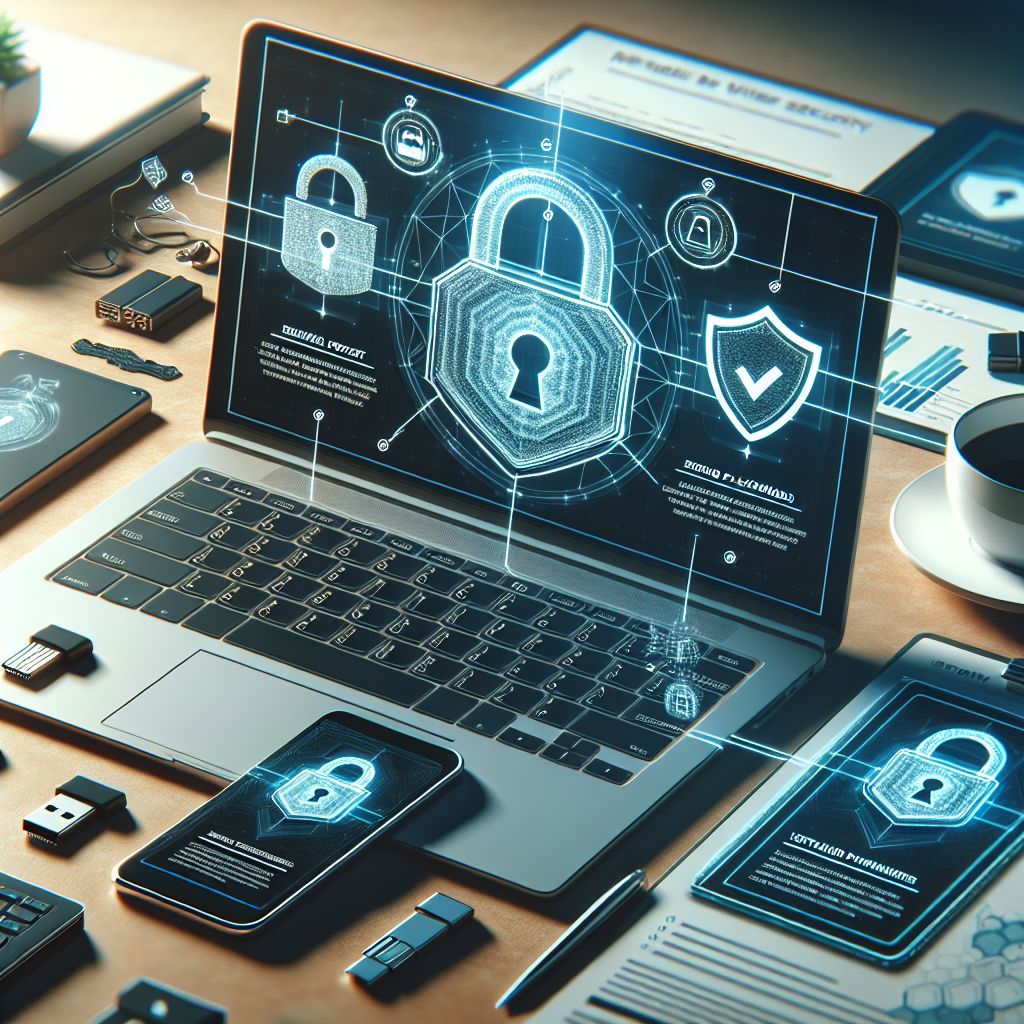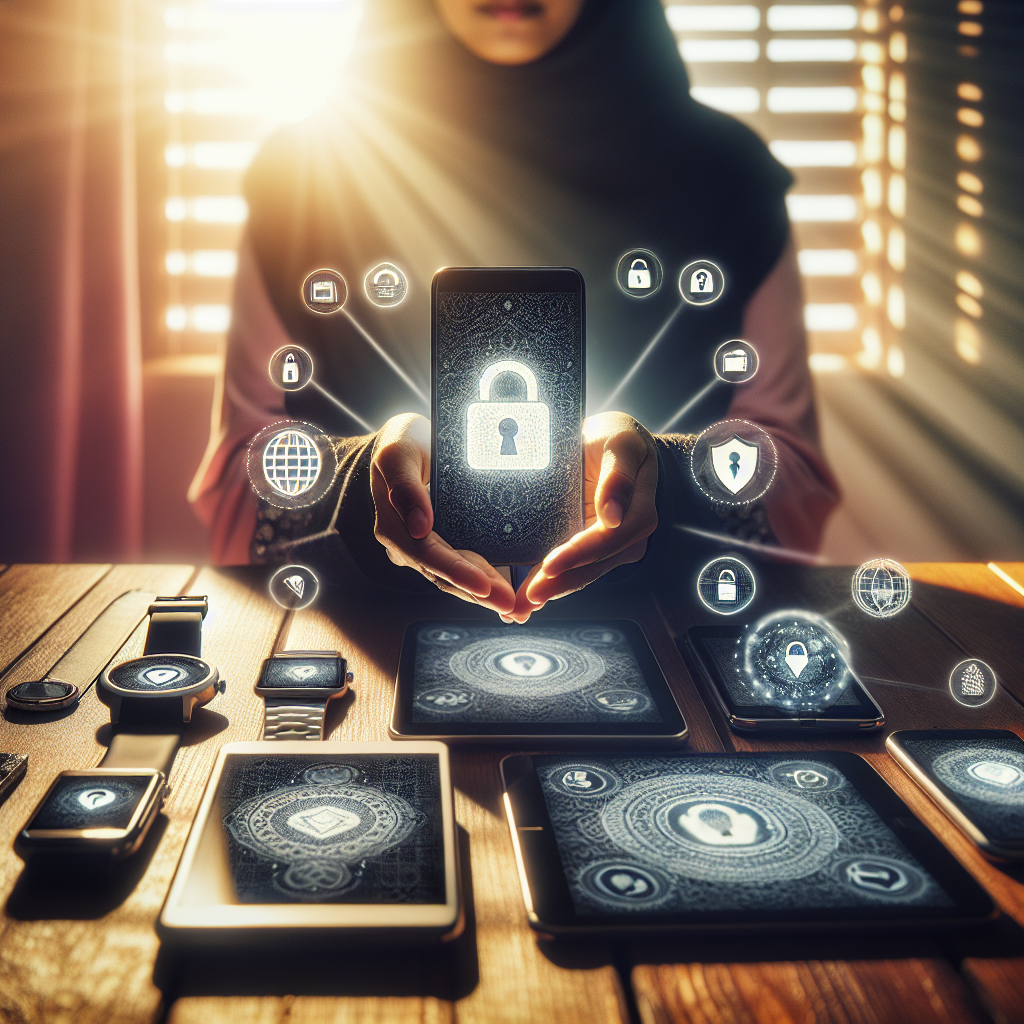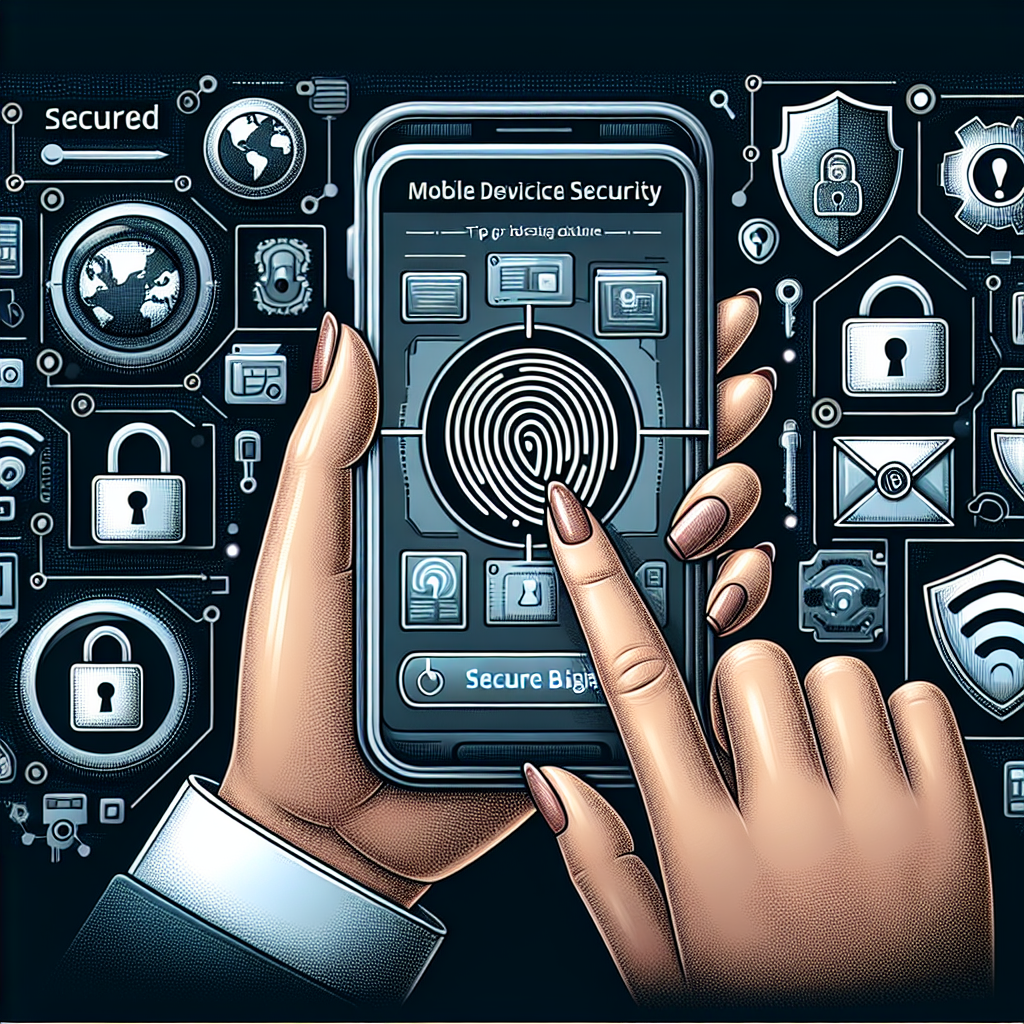In today’s digital age, our mobile devices have become essential tools for communication, work, and entertainment. However, with this increased reliance on our smartphones and tablets comes the risk of cyber threats and security breaches. To keep our valuable information safe and secure, it is crucial to prioritize mobile device security. By following a few simple tips and best practices, such as using strong passwords, enabling two-factor authentication, and regularly updating software, you can protect your personal data from hackers and malicious attacks. Stay one step ahead in the digital world by implementing these essential tips for mobile device security.
Importance of Mobile Device Security

In the digital age, where mobile devices are an integral part of daily life, it is crucial to prioritize mobile device security to safeguard personal and sensitive information. The risks associated with mobile devices have escalated with the increasing reliance on these devices for communication, work, and entertainment purposes. Security breaches can have severe implications, ranging from identity theft and financial fraud to unauthorized access to confidential data.
Understanding the risks associated with mobile devices
Mobile devices are vulnerable to various security threats, including malware attacks, phishing scams, and data breaches. With the constant connectivity to the internet and the wide range of apps installed, mobile devices become prime targets for cybercriminals seeking to exploit vulnerabilities. Users often store sensitive information such as passwords, financial details, and personal data on their devices, making them lucrative targets for malicious actors.
Impact of security breaches on personal and sensitive information
A security breach on a mobile device can lead to significant repercussions for individuals and organizations. Personal information, such as contact lists, messages, and photos, can be compromised, leading to privacy violations and potential blackmail. Moreover, sensitive data like credit card details, login credentials, and business documents can be exposed, resulting in financial losses and reputational damage.
In conclusion, understanding the risks associated with mobile devices and the potential impact of security breaches underscores the importance of implementing robust security measures to protect against cyber threats. Prioritizing mobile device security is essential in safeguarding personal privacy and maintaining the integrity of sensitive information in today’s digital landscape.

Secure Your Device with Strong Passwords
Creating a Strong Passcode
When it comes to creating a strong passcode for your mobile device, it is crucial to follow certain guidelines to enhance security measures. Here are some key points to keep in mind:
-
Use a mix of numbers, letters, and special characters: Opt for a combination of different characters to make it harder for unauthorized individuals to crack your passcode. Including numbers, uppercase and lowercase letters, as well as special characters, can significantly increase the complexity of your passcode.
-
Avoid using easily guessable information like birthdays or names: Steer clear of using personal information that can be easily obtained or guessed by others. Birthdays, names of family members, or common words should be avoided when creating a passcode. Instead, opt for random combinations that hold no personal significance to you.
By adhering to these guidelines and creating a strong, unique passcode for your mobile device, you can bolster its security and reduce the risk of unauthorized access to your personal data.
Implementing Biometric Authentication
Biometric authentication offers a highly secure method to safeguard your mobile device. By enabling features such as fingerprint or face recognition, you add an extra layer of protection that is unique to you. Biometric data, such as your fingerprint or facial features, is significantly more challenging to replicate compared to traditional passwords, making it an excellent choice for enhancing mobile security. This technology leverages the distinctiveness of your biometric markers to ensure that only authorized users can access the device, minimizing the risk of unauthorized access or data breaches.
Keep Your Operating System and Apps Updated
Regularly updating your mobile device’s operating system and applications is crucial for maintaining its security and protecting it from evolving threats. Here are some key points to consider:
-
Importance of regular software updates for security patches: Software updates often include essential security patches that address vulnerabilities discovered in the operating system or applications. By staying up to date with these updates, you can mitigate the risk of exploitation by cyber attackers seeking to compromise your device.
-
Enable automatic updates to ensure timely protection against vulnerabilities: To streamline the update process and ensure that you are always running the latest security patches, consider enabling automatic updates on your mobile device. This feature allows your device to download and install updates in the background, reducing the likelihood of overlooking critical security fixes.
Use Secure Networks and VPNs
Avoid Public Wi-Fi Networks
- Risks of connecting to unsecured public Wi-Fi hotspots
Public Wi-Fi networks are often unencrypted, making it easier for cybercriminals to intercept data being transmitted between your device and the network. This puts your sensitive information, such as passwords, financial details, and personal data, at risk of being stolen.
- Use mobile data or secure networks like VPNs for sensitive activities
To mitigate the risks associated with public Wi-Fi networks, consider using your mobile data plan or a Virtual Private Network (VPN) when conducting sensitive activities on your mobile device. VPNs encrypt your internet connection, adding a layer of security that helps protect your data from prying eyes on unsecured networks.
Implementing a Virtual Private Network (VPN)
When it comes to mobile device security, implementing a Virtual Private Network (VPN) is crucial in safeguarding your data from potential threats and unauthorized access. Here are some key points to consider when setting up and utilizing a VPN for your mobile device:
- How VPNs encrypt data transmission to prevent unauthorized access
VPNs work by creating a secure and encrypted connection between your device and the internet. This encryption ensures that any data transmitted between your mobile device and the network is scrambled and unreadable to anyone trying to intercept it. By using a VPN, you add an extra layer of security that makes it incredibly difficult for hackers or malicious actors to access your sensitive information.
- Selecting a reputable VPN service for enhanced security
When choosing a VPN service for your mobile device, it is essential to opt for a reputable provider known for their strong encryption protocols and commitment to user privacy. Look for VPN services that offer features such as end-to-end encryption, a strict no-logs policy, and a kill switch function that automatically disconnects your device from the internet if the VPN connection is compromised. Additionally, consider the server locations and speed of the VPN service to ensure optimal performance without sacrificing security. By selecting a trusted VPN provider, you can significantly enhance the security of your mobile device and protect your data from potential cyber threats.
Enable Remote Wiping and Tracking Features
Setting Up Find My Device or Find My iPhone
-
Step 1: Check Compatibility
Before setting up Find My Device or Find My iPhone, ensure that your device is compatible with these features. Find My Device is typically available on Android devices, while Find My iPhone is exclusive to Apple devices. -
Step 2: Activate the Feature
Navigate to your device’s settings and locate the section for security or privacy settings. Look for the option to enable Find My Device or Find My iPhone and toggle the switch to activate it. -
Step 3: Configure Settings
Once the feature is activated, take the time to customize the settings according to your preferences. You may choose to enable options such as remote locking, data erasure, or location tracking. -
Step 4: Test the Feature
After setting up Find My Device or Find My iPhone, perform a test to ensure that the feature is functioning correctly. Try locating your device using another device or computer to validate its effectiveness. -
Step 5: Familiarize Yourself
Become familiar with how to access and utilize the features of Find My Device or Find My iPhone. In the event of a lost or stolen device, knowing how to remotely lock or erase data can be crucial in safeguarding your information.
Remote Wiping as a Last Resort
-
Understanding when to remotely wipe data to prevent unauthorized access:
- Remote wiping should be considered as a last resort when a mobile device is lost or stolen and there is a high risk of sensitive data falling into the wrong hands.
- It is crucial to assess the situation carefully before initiating a remote wipe to ensure that all other avenues of retrieving the device or securing the data have been exhausted.
- By understanding the circumstances under which remote wiping is necessary, users can mitigate the potential risks associated with unauthorized access to their personal or business information.
-
Importance of regularly backing up essential data to avoid data loss:
- Regularly backing up essential data on mobile devices can greatly reduce the impact of a remote wipe, as important information can be easily restored onto a new device.
- Users should implement automated backup solutions or establish a routine for manually backing up data to secure cloud storage or external devices.

- By maintaining up-to-date backups, individuals can safeguard their critical data against unforeseen events that may necessitate the use of remote wiping as a last resort measure.
Be Cautious with App Permissions and Downloads
When it comes to mobile device security, being cautious with app permissions and downloads is crucial to safeguarding your personal information and data. Here are some key points to consider:
-
Review and limit app permissions: Take the time to review the permissions that apps request when you download them. Be mindful of granting access to sensitive data such as location, contacts, camera, and microphone. Limiting app permissions can help reduce the risk of unauthorized access to your personal information.
-
Protect your data privacy: By being selective with app permissions, you can better protect your data privacy. Avoid granting unnecessary permissions that could potentially expose your sensitive information to third parties. Regularly review and update app permissions to ensure your data remains secure.
-
Download apps only from official app stores: To minimize the risk of malware and phishing attacks, it is recommended to download apps only from official app stores such as the Apple App Store or Google Play Store. These platforms have security measures in place to detect and remove malicious apps, reducing the likelihood of downloading harmful software onto your device.
-
Beware of third-party app stores: Avoid downloading apps from third-party app stores or unverified sources, as they may pose a higher security risk. These sources are less regulated and may distribute apps that contain malware or other security vulnerabilities. Stick to reputable app stores to ensure the apps you download are safe and secure.
By being cautious with app permissions and downloads, you can enhance the security of your mobile device and protect your personal data from potential threats and breaches. Remember to stay vigilant and prioritize security when using apps on your device.
FAQs – Tips for Mobile Device Security
What are some basic tips for enhancing mobile device security?
To enhance mobile device security, it is important to enable passcode or biometric authentication to prevent unauthorized access. Regularly update both the operating system and applications on your device to patch any security vulnerabilities. Avoid connecting to public Wi-Fi networks and always use a virtual private network (VPN) when accessing sensitive information. Be cautious when downloading apps and only install from trusted sources such as official app stores. Lastly, enable remote wipe features in case your device is lost or stolen.
How can I protect my mobile device from malware and phishing attacks?
To protect your mobile device from malware and phishing attacks, it is recommended to install a reputable antivirus app and regularly scan your device for any malicious software. Be cautious of suspicious links and emails, especially those requesting personal information or login credentials. Avoid downloading attachments or clicking on links from unknown or untrusted sources. Additionally, always verify the legitimacy of websites before entering sensitive information and enable two-factor authentication for an added layer of security.
What should I do if I lose my mobile device or it gets stolen?
If you lose your mobile device or it gets stolen, immediately contact your service provider to suspend your phone line to prevent unauthorized usage. Use the tracking features available on most devices to locate or remotely wipe your device if possible. Change any passwords or credentials that may have been stored on the device, especially for financial accounts and sensitive information. Lastly, consider reporting the incident to the authorities and providing them with any necessary information for potential recovery of your device.
How can I secure my mobile device when using public Wi-Fi networks?
When using public Wi-Fi networks, it is important to use a virtual private network (VPN) to encrypt your internet traffic and prevent potential hackers from intercepting your data. Avoid accessing sensitive information such as online banking or entering passwords while connected to public Wi-Fi. Disable any automatic Wi-Fi connections on your device to prevent unintentional connections to unsecured networks. Additionally, always verify the legitimacy of the Wi-Fi network and confirm with the network provider if possible.

Leave a Reply